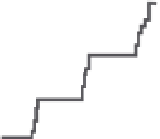Geology Reference
In-Depth Information
Models for Earthquake Slip
σ
1
σ
1
σ
2
σ
2
u
u
u
u
predicable time
long-term
slip rate
unknown
slip
predictable
time
unknown time
intra-cluster
slip rate
predictable slip
predictable slip
t
t
t
t
time
Periodic
model
time
time
time
Time-predicable
Slip-predictable
model
Clustered-slip
model
A
B
C
D
model
Fig. 4.4
Models for earthquake recurrence.
A. Periodic earthquake model in which stress levels at the time of rupture and after it are known. These thresholds
yield a predictable time and slip for each earthquake. B. Time-predictable model based on a consistent stress level at
which failure occurs. Stress drop and slip magnitude are unpredictable, but, given previous slip, time until the next
earthquake (with unknown slip) is predictable. C. Slip-predictable model based on a consistent stress level at the end
of an earthquake. Given time since the last rupture, magnitude of slip is predictable. D. Clustered-slip model has no
consistent stress levels for the start or end of an earthquake, but predicts that earthquakes will tend to group together
in time, and that short-term and long-term rates may vary significantly. Modified after Shimaki and Nakata (1980) and
Friedrich
et al.
(2003).
but that, whenever an earthquake does occur,
the likelihood of another earthquake occur-
ring soon thereafter is high.
Asperities versus Barriers
"Before"
"After"
Stressed
Asperities, barriers, and characteristic
earthquakes
Barrier
Asperity
What controls ruptures?
Unstressed
In an effort to understand why and when
earthquakes occur, many scientists have
searched for patterns of ruptures that, if fully
understood, could form a basis for predicting
subsequent seismic events. Earthquakes clearly
occur when the strength of a fault is exceeded.
But, what controls that strength and does it
change between earthquakes? In southern
California, all of the recent large earthquakes
(
M
Fig. 4.5
Model of asperities and barriers along
a fault plane.
Barriers (unruptured regions) can remain after faulting
and may stop the propagating rupture. Asperities may
exist before rupture and determine the strength of the
fault and where ruptures initiate. Modified after Aki (1984).
5) have occurred on faults that were
“loaded,” that is, the stress on them was increased
by a nearby earthquake in the previous 18
months (Harris
et al.
, 1995). Moreover, it seems
≥
probable that localized segments or patches of
some fault planes control the strength of some
faults, whereas other parts are at times relatively



























































































































